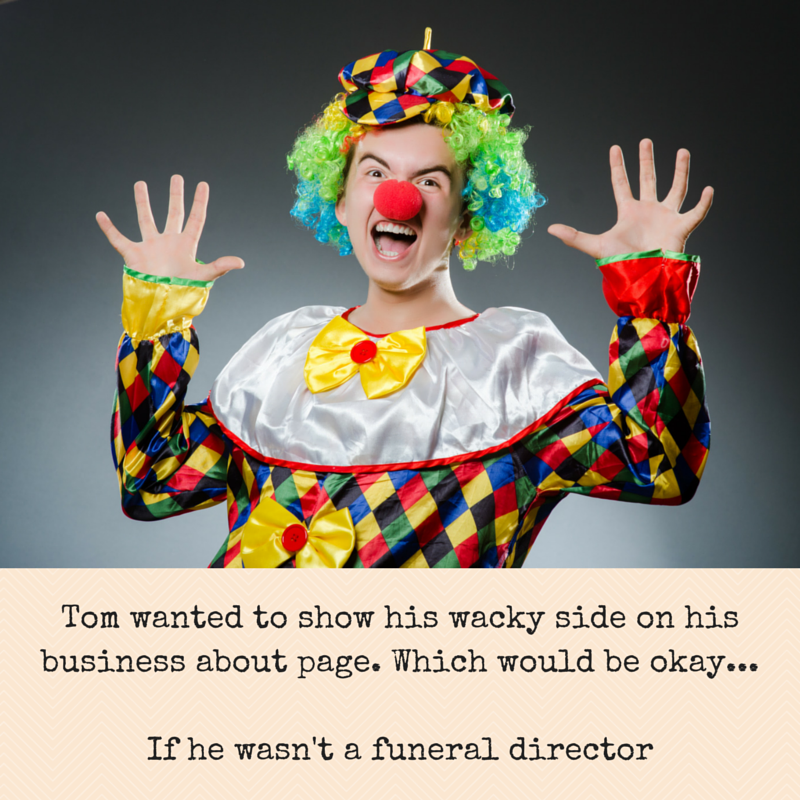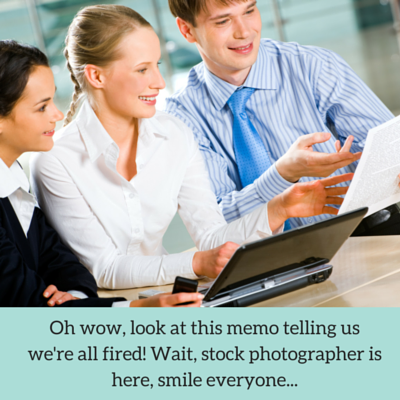
One of the most visited pages on your website, your About Page is where customers go to get a deeper understanding of you, your business, your ethos and what you offer.
It’s also one of the hardest pieces to write.
And one of the easiest places to make mistakes that drive perfect customers away. Not good.
Below you’ll find a quick checklist of about page errors that can make your business look unprofessional. At the end of this post you’ll find a top resource to help (including the chance for free feedback on your own business about page).
Let’s go:
1. You miss out crucial details
Sometimes the most obvious details are the ones we forget to tell people. It reminds me of conversations with my mum who sometimes gets so excited telling a story she forgets to include important points that completely change the context:
Mum: So there I was in the supermarket talking to Judy by the bananas. It was so lovely to see her. And the topless waiters were wonderful!
Me: At the supermarket?!
Mum: No silly, at your aunty’s hen party back in 1964.
Me: Of course.
Okay, there weren’t any topless waiters at my aunty’s hen do back then, but talking with my mum may involve elements of scene changes and time travel that you’re not always told about.
How does this relate to your About Page? Well you can forget that this may only be the second page your customer visits on your site. They may still be pretty uninformed about you and what you do. So important details may include:
- Your name / business name
- Where you’re based
- Who you serve
- How people can get in touch with you
Think about the details you’re looking for when you visit a business website. Can you find those same details on your about page?
2. The photo doesn’t match your style, or worse: it’s stock…
If you’re a coach, or consultant, use a photo of yourself. If you expect people to work with you on a personal basis one to one, nothing fast forwards the confidence in that relationship than a lovely smiling photo of you. If you’ve got a cute puppy to hand, grab it (as long as it’s yours).
But make sure the photo matches your style. If you run a serious business consulting service, don’t use that photo of you on a canal boat wearing a sailor’s hat and holding a plastic cup of bubbly. (Yes one exists. No I’m not sharing).
Or worse, you use a stock photo like this:

People recognise stock photos and while they can look polished and slick, it’s the same polished and slick image being used on thousands of other business websites out there.
Much better to use a real photo, either of you, your team, your workshop, your office etc. Keep it real and build a closer connection to your prospects.
3. You make it ALL about you
This is the most confusing part. Your about page isn’t actually ‘about’ you, well it is, and it isn’t. Confusing I know, that’s why so many mistakes are made.
Your about page is about you in whatever way this is relevant to your customer’s interests.
Avoid that anecdote about your first kiss in the woods, followed by a tree swing over the stream that broke, resulting in you wearing a bin bag for the rest of the school trip that day… If you’re an accountant, or say, well a copywriter, that’s not something your customer needs, or wants to know.
Relevant skills, qualifications, experience, all great. The stories about how you were destined to be a management consultant the Christmas you received the PlaySkool office toy, not-so-great.
4. It’s a bit dull
Your about page isn’t just the facts and figures of your business however, it should tell some kind of story to hook your reader in. But if you can’t tell those hilarious anecdotes about yourself, how do you tell an engaging story?
A good starting point is telling a story about:
What drives you to help your customers
This kind of story is the perfect pairing between you and your customer. It reveals your character and personality, while focusing on the customer and what interests them. For example:
I started my ice cream parlour for country music lovers because I realised that country music fans had nowhere to go to buy ice cream that showed their devotion to their favourite stars. Here you can get the Kenny Rogers Rocky Road, the Dolly Parton Pistachio and the famous George Jones Whiskey ice-cream, but we will have to confiscate your car keys if you choose that one.
In short tell a story that says:
- This was a problem I noticed
- These people were suffering
- That made me mad / inspired
- I created this solution
- Here’s how it makes people happy
A perfect blend between you and your customer.
5. You don’t tell people what you do
This is a very simple but common mistake. So I’m going to ask you to do a quick check now on your about page. Do you tell people:
- What you do?
- Who you work with?
- How you work?
If not, go pop those details in right now. I’ll wait.
Done? Great, on to number 6:
6. You brag…
If you’ve made this mistake I whole heartedly understand because it’s difficult to strike the balance between saying:
Hey, you should trust me and here’s why
And:
Love me, love me, I’m AMAZING!
And so on some about pages, it seems as though there’s no room for the customer:
“Then I won this amazing award at work that everyone wanted, but no-one else got but me, and it was because my boss said I was the only one there who really went above and beyond. And so then I started my own business and it did so well, in the first 6 months Richard Branson was calling me up for ideas (he’s a bit needy but I do like his airline)…”
Again, I have a simple rule to stop you falling foul of the bragging about page:
Every time you say something good about you or your skills, tell your customer how this helps them
For example:
I’ve got 7 years dog training experience with several awards for pre-show training. This means I can guide you on all the best techniques for training your dog for shows, as well as making sure you know what to expect as a dog-owner.
7. No social proof
You need to show that you and your business don’t exist in a vacuum. If you have an about page that only feature what you think about your business, it’s going to be treated with a little scepticism.
Show that you have helped other people, mention any publications you’ve been in, showcase a testimonial. Show people that you are real in the real-life world and not simply existing on a web page.
8. There’s no next step
And that, was the end of that…
You don’t want to finish your about page with everything neatly tied up and rounded off. You want to lead your customer elsewhere. Your about page should not be a dead end, a cul-de-sac, a brick wall, a closed gate a… you get the picture.
It should encourage your reader to explore further. You’ve whetted their appetite with informative details about your business, now what should they do?
- Do you have a popular article they should check out?
- Is a good next step to get in touch with you?
- What about signing up to your newsletter?
Give them somewhere to go and guide them there.
9. It doesn’t serve your business goals
Okay, your about page really is about you. I know – confusion reigns right?
It’a about you in that, it should help serve your business goals.
If you want more clients, do everything you can to let your clients know how your service can help them.
If you want media coverage, let journalists and media outlets know what they’re going to gain if they feature you as an expert.
If you want to talk at conference, make it clear what audiences will take away should you be asked to appear on stage.
You about page should be building a bridge between your customers needs and what you can offer. It’s not just a static page of content, it’s a page that encourages momentum and moves your ideal target market closer to doing business with you.
Want me to help you with your About Page?
Next Wednesday 22nd July at 5pm UK time, I’m releasing a Copywriting Lab video all about About Pages. Here’s what you need to know:
- I’ll be covering practical tips you can use to boost the persuasive powers of your About Page
- You can send in your about page before MONDAY for the chance for me to review it in the video and provide tailored feedback
- I’ll be hosting a live Tweetchat when the video is released to answer any other questions you might have
- The video will be available for a few days after if you can’t make it for the release date
To sign up for the Copywriting Lab and get a check-up for your about page, click here.
New to Harrisonamy? Don’t forget you can find me on the weekly Hit Publish podcast on Rainmaker.FM for Copyblogger.

I couldn’t have agreed more Amy,
Most people usually fail woefully while writing their about page and often time, this same about page is the first page first time visitors to our site visits.
You only have few seconds to impress them via your about page or they’re gone so, why not make it interesting and compelling?
One of the about pages I really admire so much is that of Michael Hyatt, its so wonderful that I always want to read and reread it again and that’s how interesting an about page should be.
Its not something you’ll just have to rush, you need to cool down and write a very nice stuff.
Mine is not yet perfect though, but I’m still working on it gradually after reading that of Michael Hyatt and many others.
Thanks for sharing Amy, very lovely indeed :).
You’re welcome Theodore, thanks for taking the time to comment. Michael Hyatt is an excellent example. His About page showcases his business goals such as speaking and made appearances and is full of credibility builders. Thanks for pointing people in his direction!
Hi Amy,
Great post here. I resonate with number 4 as stories sell and your audience tends to relate best when you tell stories. One thing I would add to this list is make sure you have all 9 parts, but maintain a conversational tone. Thanks for sharing.
Kurt
Thanks for your comment Kurt! A conversational style is a great copywriting tool as it’s not just about the information on the page but the delivery too. Thanks for pointing that out. 🙂